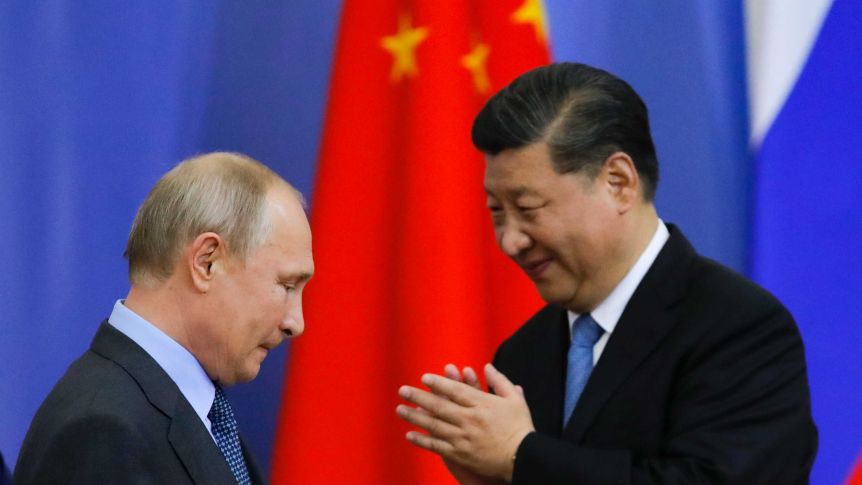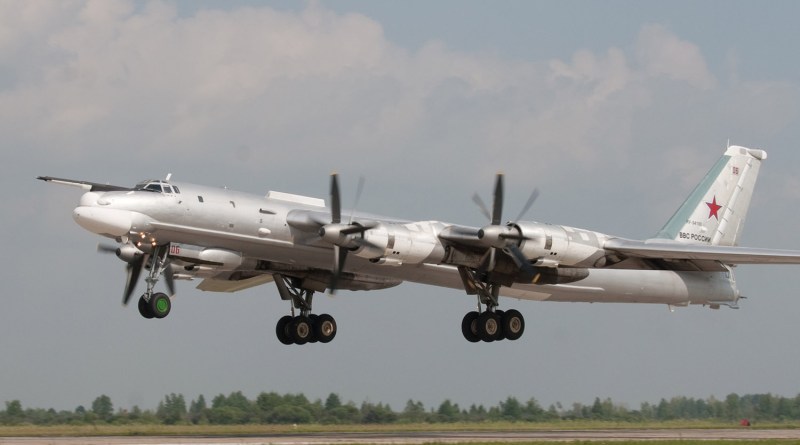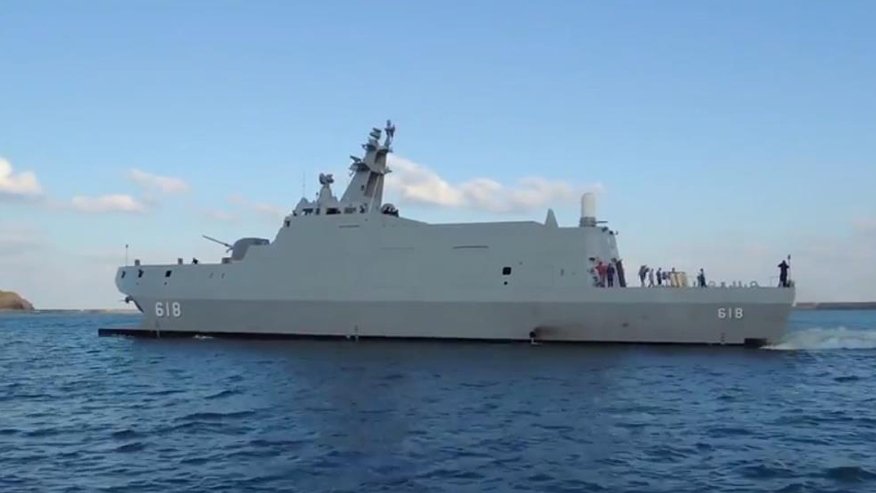 Russian President Vladimir Putin (L) & Chinese counterpart Xi Jinping
Russian President Vladimir Putin (L) & Chinese counterpart Xi Jinping
The joint aerial strategic patrol held by the air forces of Russia and China on December 22 over the Sea of Japan and the East China Sea makes a big statement in the geopolitics of the Asia-Pacific region. Chinese experts have hinted that such events could become “routine” in future.
The Chinese and Russian defence ministries made a joint announcement on the occasion Tuesday. China sent four nuclear-capable H-6K strategic bombers “to form a joint formation” with two of Russia’s famous Tu-95 bombers (NATO reporting name: “Bear”) to conduct the joint patrol as “part of annual military cooperation plan” between the two countries.
The announcement said the joint patrol “aims to further develop the China-Russia comprehensive strategic partnership of coordination in the new era, and enhance the level of the two militaries’ strategic coordination and joint operational capability to jointly safeguard global strategic stability.”
Curiously, only a month ago, on November 6, two Tupolev Tu-95MS strategic missile-carrying bombers of Russia’s Aerospace Force had performed a scheduled 8-hour flight over the neutral waters of the Sea of Japan and the north-western Pacific. Russia’s Defense Ministry said “At some sections of the route, the strategic missile-carrying bombers were escorted by Su-35S fighters.”
 Russia’s Tu-95MS Strategic Bomber (Filephoto)
Russia’s Tu-95MS Strategic Bomber (Filephoto)
Clearly, the joint patrol with China was not an absolute must from the perspective of Russia’s national defence. But its optics and messaging mattered. This has everything to do with the regional setting with the US and its partners stepping up.
On Dec. 19, USS Mustin conducted a transit through the Taiwan Strait; on Dec. 20, Taiwan conducted a live-fire drill in the Pratas Islands (approx. 300 kms from mainland China) and plans to conduct another on Dec. 27. Pratas Islands are strategically located near the gateway to the South China Sea and is a waypoint for oil tankers and Chinese vessels en route to the Pacific Ocean.
Last week, Taiwan launched its first missile corvette, which Taiwanese press described as an “aircraft carrier killer”, even as PLA Navy’s first Chinese-made aircraft carrier, the Shandong, completed its third sea trial in a 23-day in the Bohai Sea.
Also this month, a US Navy Amphibious Ready Group (ARG) consisting of the USS Makin Island and USS Somerset (LPD 25) patrolled the South China Sea and conducted “unscripted” live-fire drills. The Chinese state-run newspaper Global Times angrily called the ARG as “US muscle-flexing actions” that “could damage regional stability,” and commented that “China should be prepared to confront the US in the South China Sea and the Taiwan Straits no matter who sits in the White House.”
Japan has bestirred itself lately, inviting like-minded Western countries to send military units to the Far East signalling that they are united in seeking a free and open Indo-Pacific region. The US, French and Japanese navies conducted integrated exercises in the Philippine Sea in December focusing on anti-submarine warfare; another joint military exercise is planned for May on an outlying Japanese island; UK plans to send an aircraft carrier strike group to conduct joint exercises with the US Navy and Japanese Maritime Self-Defense Force (JMSDF) early next year.
The Japanese Defense Minister Nobuo Kishi held talks last week with his German counterpart Annegret Kramp-Karrenbauer where he “expressed hope that a German vessel” would join exercises with the JMSDF in 2021 and “suggested it would assist the international community’s efforts to ensure the right of passage of vessels through the South China Sea if the German warship would traverse waters” over which Beijing claims jurisdiction.
 Taiwan Navy’s first stealth ‘carrier killer’ corvette Tuo Jiang
Taiwan Navy’s first stealth ‘carrier killer’ corvette Tuo Jiang
Amidst all this, the US’ Naval Service released an integrated maritime strategy designed to take a “more assertive (approach) to prevail in day-to-day competition (with China) as we uphold the rules-based order and deter our competitors from pursuing armed aggression.” Also, the US secretary of the Navy has called for the reestablishment of the 1st Fleet, a numbered Navy fleet, “in the crossroads between the Indian and the Pacific oceans.”
On Dec. 18, the US began building on the second Quad Foreign Ministers’ Meeting in October by organising a virtual “Quad” meeting of senior diplomatic officials from the US, Australia, India and Japan. The US State Department readout said the four countries discussed “practical ways … to coordinate efforts to support countries vulnerable to malign and coercive economic actions in the Indo-Pacific region.”
There is much speculation about how the Biden administration will approach the Indo-Pacific. So far, Biden has not mentioned Quad, but he uses the phrase “Indo-Pacific.” But instead of discussing a “free and open” Indo-Pacific (as Trump does), Biden uses the phrase “secure and prosperous.”
To be sure, given the high stakes involved, China and Russia will not take chances. Their joint aerial patrol Tuesday reflects common concern over the region’s strategic stability. Both countries take note of growing interference by extra-regional powers inciting frictions, potentially posing a major threat to regional peace. Meanwhile, the US is deploying anti-missile systems and keeps talking about a NATO-like military alliance in Asia.
In sum, the joint patrol signals that China and Russia are “the linchpins of peace and stability in the Asia-Pacific region and Eurasia. They have no intention to challenge the regional order. They are propelled to respond to external powers which threaten regional security”, as a prominent think tanker at the Institute of Russian, Eastern European and Central Asian Studies under the Chinese Academy of Social Sciences, Yang Jin, put it.
Chinese pundits have discussed the pros and cons of a Sino-Russian military alliance, the consensus opinion being that in the prevailing security environment, the existing format of strategic partnership serves the purpose of meeting common challenges while giving flexibility to serve the self-interests each side. Having said that, military alliance also remains “a last option for the worst situation – when the US or another country launches a war that forces China and Russia to fight side by side” — to quote Yang.
An editorial in the Chinese Communist Party daily Global Times noted, “China and Russia have no intention of forming a military alliance because it cannot resolve the comprehensive challenges the two countries have to face” but the pressure from the US and its allies have “provided an important external impetus” to the strengthening of the comprehensive strategic cooperation as such, including military cooperation.
“As long as they cooperate strategically and jointly deal with challenges, they can generate effective deterrent, form a joint force to deal with specific problems, resist the attempts to suppress the two countries and curb the US’ international misconduct,” the editorial said.
The US-Russia-China triangle is sure to transform under the Biden presidency if Washington sets sights on Moscow as the biggest threat to the US national security. Unsurprisingly, Beijing is signalling that the China-Russia strategic partnership should remain close and continue to be strengthened to handle increasing pressure from the US, even if Biden might ease tensions with Beijing.
This strategic emphasis is the leitmotif of an unusually lengthy report by Xinhua in the People’s Daily on the phone conversation between the State Councilor and Foreign minister Wang Yi with his Russian counterpart Sergey Lavrov on December 22.
